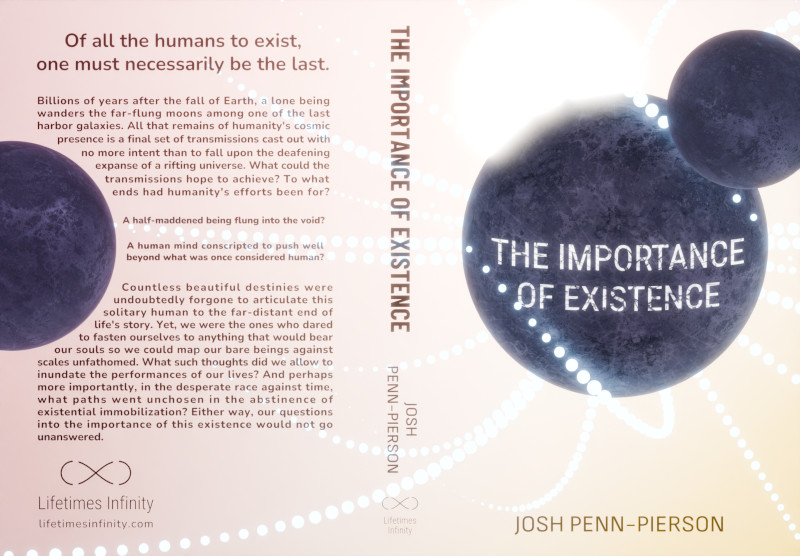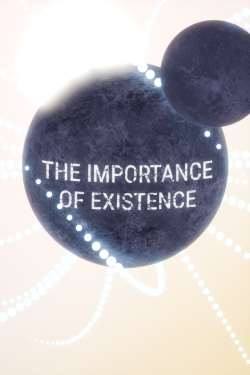The Importance of Existence is a philosophical hard science fiction book I wrote to capture the vision and mission of Lifetimes Infinity. The book is formatted as a series of transmissions sent out by the last human being in existence as they reflect on humanity's story and the human condition.
As the sole creator of the book, my responsibilities spanned conception, outlining, project management, writing, editing, science verification, visual design, publishing, and marketing.
Release Date: 2024-07-23
Availability: Lifetimes Infinity Store, Amazon, Barnes & Noble, Google Play, Kobo
Book Tagline: Of all the humans to exist, one must necessarily be the last.
Book Blurb:
Billions of years after the fall of Earth, a lone being wanders the far-flung moons among one of the last harbor galaxies. All that remains of humanity's cosmic presence is a final set of transmissions cast out with no more intent than to fall upon the deafening expanse of a rifting universe. What could the transmissions hope to achieve? To what ends had humanity's efforts been for?
- A half-maddened being flung into the void?
- A human mind conscripted to push well beyond what was once considered human?
Countless beautiful destinies were undoubtedly forgone to articulate this solitary human to the far-distant end of life's story. Yet, we were the ones who dared to fasten ourselves to anything that would bear our souls so we could map our bare beings against scales unfathomed. What such thoughts did we allow to inundate the performances of our lives? And perhaps more importantly, in the desperate race against time, what paths went unchosen in the abstinence of existential immobilization? Either way, our questions into the importance of this existence would not go unanswered.
Project Challenge: Efficiently Create Book Art
Solution: Modular and Programmatic Art
I used Blender to build a 3D scene for the book's cover art. This allowed me to quickly prototype each individual element and then modularly construct the scene out of the various elements I decided to use. Even the text is all in Blender, giving the whole scene a more immersive feel. This modular construction has been greatly beneficial in allowing me to make the cover very early on in the process without having to worry about inevitable revisions (since the final page count of the book determines how thick the spine is, and also since it took me a while to decide on the book's dimensions).

I created the the light orb tendrils using Python scripting inside Blender. I wrote procedural generation code to randomize the movement paths the tendrils took so that I could feed in random seed phrases until I got a configuration I was happy with. This allowed me to quickly prototype various numbers of tendrils, different movement directions, and different starting positions.
Within the book, there are several graphics I created using HTML Canvas and JavaScript. As with the cover, making these graphics programmatically allowed me to rapidly prototype my ideas until I had a solid vision for the end product.


Project Challenge: Create a Plausible Story Timeline
Solution: Simulations and Equations
One of my goals with the book is to give people an idea of what the opportunities are available for humans on a universal scale (in both space and time, and without breaking physics). To achieve this, I learned what I could from available Astrophysics material to then form a crude timeline upon which I wrote the initial draft of the book. Once I was happy with the content of the book, I made note of all the science entries. From there, I spent a month nailing down every aspect of science in the book through the following steps:
- I hunted down and combed through Astrophysics content to compile a document of references on values and equations relevant to the book that I would need to further expand upon in the next steps.
- I programmed crude simulation software in Python and JavaScript to give me fairly precise values for all the hard claims I wanted to make in the book.
- With my new Astrophysics understanding, I derived multiple equations to precisely calculate all the values I had previously simulated. This acted to both double-check my work and give me formulas I could share in the book to mathematically describe the story.
Below are the charts used in the book (in the order they appear in the book). For any of the science-interested people who read the book, the equations help paint the story of a being who has existed for a long time and has learned a lot. For anyone who doesn't care about the science, the charts still help convey the story, and the math can be easily glossed over, as the formulas are all contained to one chapter of the book.











